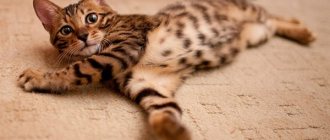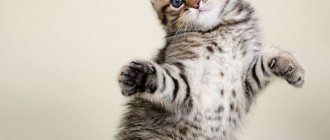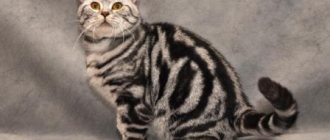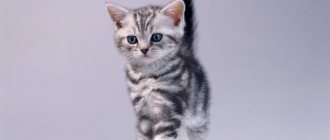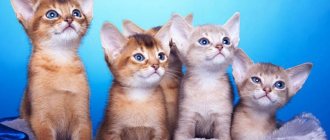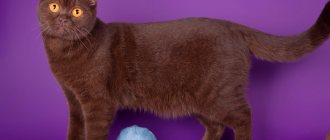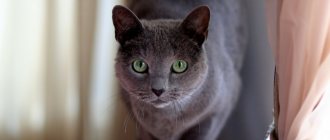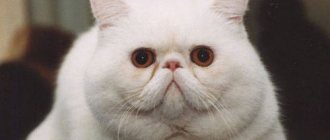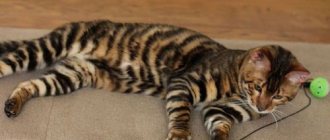The Abyssinian cat with a fawn color is a graceful animal that looks very much like a miniature copy of a young lioness. These cats have a very beautiful short coat of delicate cream color. Some compare the shade to the color of coastal sea sand. “Faun” or “fawn” is recognized by international felinological associations and allows Abyssinians to participate in exhibitions and breed shows.
CINNAMON and FAUN
|
| New, one might say the newest, colors in the British breed. They are very popular and in demand, but are still very rare. Although several articles have already been published on this color, we think it would be useful to briefly recall the history and development of this color. The first attempts to introduce cinnamon and fawn colors to the British were made in the 90s. Moreover, this happy thought for us came to several breeders from different European countries. So almost at the same time, British breeders in England, Belgium and Holland began to introduce this color into the British breed. Moreover, the Belgians and Dutch used mainly Abyssinians and Persians, and the descendants from these interbreed marriages were tied to the British CASH. English breeders acted differently; they used cinnamon-colored Orientals when mating directly with the British. Now you can argue which breeding path was more correct and correct, we will not do this. In my opinion, the British only benefited from this, the breed received for the development of the cinnamon color, several different blood lines that did not intersect with each other. This greatly facilitated the selection of manufacturers for further work. Cinnamon is lighter than chocolate and has a warmer tone. It owes its appearance to the b' – brown light gene, which promotes further oxidation of melanin. In this case, the nose is colored pinkish-brown (almost beige), as are the paw pads. As cinnamon-colored cats grow up, they acquire a warmer tone with a reddish-brown sheen, while the undercoat at the base is always slightly lighter than the main coat and this is not considered a disadvantage in cinnamon. With the cinnamon color: the coat color is red-brown (cinnamon color), the undercoat is yellow-brown, lighter than the main tone, and the red tone of the coat is light copper, sometimes bronze (in bicolors), and not orange like in reds and is never brick-gray . In kittens, the paw pads, nose mirror and rims of the lips and eyes are very light, almost white with a slightly pinkish tint, and in adult animals they are the color of cocoa with milk, darkening to the color of milk chocolate when stressed. The faun's light beige, sandy color is sometimes called Fawn. The nose, paw pads and rims of the fawn color are pink-beige, of a very delicate tone. Due to its recessiveness, the cinnamon color is very difficult to breed, which means that to obtain it you need to have several different blood lines carrying this color, and at the same time select the right partners so as not to get a simplified type. But what a joy it is when kittens live up to your expectations! A more detailed article about these new and unique colors can be found here >>> |
| Kelvin Katrin's & Capriz British fawn cat | Know How vom Grutholz British cat cinnamon |
| Rivium's Nina Ricci British cat cinnamon with white |
In preparing the article, materials from the official websites of CFA, TICA, and WCF were used. “Secrets of the red color” V. Pokhvalina, Friend Magazine 1999 “Genetics for Dummies” Zh.P. Maas translated by E. Shevchenko “Cats, breeding, genetics and exhibitions”, E. Shevchenko. “British and Scottish fold cats”, I. Shustrova, A. Ashatkin, A. Vasiliev The article uses photographs by E. Kurchevskaya, A. Utekhina, E. Chelyaeva, I. Rozova
Kurchevskaya E., Rozova I., 2007
Solid colors
The color should be solid and uniform, without variegated hairs, spots, shades or patterns.
The fur of such cats is short and thick, and soft to the touch, like plush.
British black cat
Blue British kitten
Photo of a British chocolate cat
Lilac color of British cats
- Red (red, golden)
Photo of a red British cat
- Cream (peach, beige)
Photo of a cream British cat
Photo of a white British cat
Eye color is bright copper or orange, and white British people can have blue or even multi-colored eyes.
White British kitten with blue eyes
Odd-eyed Briton
The very rare solid color cinnamon was developed quite recently.
It is much lighter than chocolate and is called the color of ground cinnamon.
Chocolate Britons have a nose color that is slightly darker than the coat or matches its color, while Cinnamon, on the contrary, has a pinkish-brown nose that stands out against the darker coat.
British cat cinnamon
Cats of the fawn color (also called the color of a young fawn) have fur of a warm light beige shade, and the pads of their paws and nose are a delicate pinkish color.
The eye colors of cinnamons and fauns range from golden to rich copper.
British fawn cat
The solid color of British cats is uniform, without spots, patterns or any white hairs. The coat looks and feels plush, thick and soft.
Classic and most common. It is this color that comes to mind when it comes to British cats. The coat of this color should be uniform, while the undercoat may be slightly lighter than the main color, but whitish hairs are unacceptable. The lighter blue color is especially valuable.
Black color
This is a rare color, it is difficult to obtain and is considered “capricious”. It often happens that a kitten born black changes its coat color to chocolate as it ages. The pigmentation of the coat, undercoat and skin is rich. In this case, the color of the undercoat and coat should not differ. It is believed that the more unbleached colors the ancestors have in their pedigree, the richer the black color will be. The rule of mating like with like, without experiments, so as not to harm the breed, applies here.
White color
The white color of a British cat's coat should be pure, without yellowness or spots. Kittens may have blue or black stripes on their foreheads, but they disappear with age. Eye color coding is indicated by a number, thus 61 – blue (or) blue eyes, 62 – orange, 63 – odd-eyed, 64? green. I wonder what the name itself is “white”?
It’s not a color, but its absence, which is why in the group of solid shades, white stands alone. It is quite difficult to breed animals with perfectly white fur, and obtaining such a color is associated with a high risk of producing unhealthy offspring. Thus, white parents have a high probability of giving birth to offspring with deafness. Since 1997, breeding work with white color has been stopped.
This is a bleached red that is produced by the presence of a bleach gene. This shade of coat is one of the oldest types of solid colors, but recently it has become rare in breeding. The cream-colored British must have a clear (pastel) shade, intense color, and color i.e.
Chocolate color
Should it be rich and deep? the darker the shade, the better. This color is also called havana or chestnut.
Recently, breeders, as a result of careful selection of offspring, i.e. future producers have achieved high quality wool, in no way inferior to classic blue. The fur of such cats looks like a mouton. For the British, the standard recognizes all shades of chocolate: from light milky to dark “bitter”.
Lilac color
Lilac coat color of a British cat? it is a combination of grey, pink and blue colors and looks like bleached chocolate. The animal's nose, as well as its paw pads, match the tone of its coat. Eyes orange-copper shades. The lilac color is presented in various variations: from cold lavender to warm pink-gray.
The undercoat of cats of this color may be slightly lighter in tone than the outer hair, but a pronounced contrast is not acceptable. Kittens often have a residual pattern (moire) that disappears with age. The quality of the wool of lilac British cats resembles a blue mink coat, the color of which is mixed with a little pink dye. The nose, paw pads and lining of the mucous membranes are pink-purple in color, which darkens slightly with age.
The red color of the Briton was introduced from Persians and other exotic cat breeds that have a red tint to their coat. These cats often have tabby markings on their foreheads. The eyes of British cats with red fur have a rich orange color. The shade of the nose and paw pads is red, brick. A significant drawback of the red coat of the British is the uneven color distribution; for example, a cat's tail often has a lightened tip, so it is quite difficult to meet a Brit with a uniform red color. In view of this, the standards allow for a small, weakly defined tabby pattern.
Most popular colors
Among all this variety, blue and purple colors are considered the most popular. They are the easiest to remove and have the fewest claims regarding cleanliness. Not long ago, a new species of British with a golden color was developed, which today is considered one of the rarest and most beautiful. Gold-colored wool looks especially impressive in combination with emerald eyes - this condition is mandatory when determining quality standards. No other eye color is accepted for golden-hued individuals. The coat is soft, with a double undercoat the color of ripe apricot, slightly longer than that of the solid-colored British group.
No other eye color is accepted for golden-hued individuals. The coat is soft, with a double undercoat the color of ripe apricot, slightly longer than that of the solid-colored British group.
Also very popular are kittens with silver skins. Various admixtures of gray and black shades are allowed, but the presence of yellow spots is considered a gross violation of accepted standards. However, unlike “golden” kittens, representatives of the silver breed can have eyes not only green, but also all shades of yellow and orange. During the first year of life, silver kittens may change the color intensity, as well as the pattern itself. It may become more pronounced or, on the contrary, weaken its presence.
British golden and silver cats are divided into several subspecies.
- Shaded (or veiled), when the pigment appears only at the tips of the hairs, and the undercoat remains white. At the same time, the overall tone is even, without a pattern.
- Ticked when the pattern is clearly visible. It may be spotted or striped, or marbled or otherwise, but it is clearly marked.
Types of colors
The main types of coat color of the Abyssinian cat:
- classic wild;
- blue;
- sorrel;
- faun.
In addition to the four main colors included in the breed standard, there are other types of colors of Abyssinian cats:
- lilac;
- brown;
- tortoiseshell;
- black.
Black Abyssinian cats are spectacular and elegant. Despite the fact that this color is not included in the standard, they are popular.
In fact, the fur of these cats is dark chocolate or black-gray. The belly is lighter - gray or brown.
It is difficult for breeders to achieve the consolidation of black color in the color, because there are very few Abyssinians with black ticking.
Classic wild color
At first, this color was the only color standard for the Abyssinian cat breed. Today this is the most common and popular shade. It contains rich ocher, brown, and black tones.
Compliance with standards is determined by the following parameters:
- ticking must be uniform, at least 3 segments;
- the sides and back are painted a darker ocher-brown color than the lower part of the body;
- the paws have black fringes;
- a black stripe runs along the entire length of the ridge;
- the nose is terracotta-colored, clearly defined;
- eyes the color of gold, walnut, emerald.
Different degrees of shade intensity are allowed
It is important that no extraneous colors are mixed into the base ones.
Interesting! All kittens are born with blue eyes. Only by the age of ten months do their eyes acquire a color that matches their color.
Sorrel
Sorrel translated from English means “bay, red.” This color is warmer than the classic one; it is dominated by red shades of wool, the color of copper, apricot, and chocolate.
Characteristics:
- the main ticking background can be of two types: dark chocolate or cinnamon color;
- The presence of black hairs in the wool is unacceptable;
- the tummy and paws are colored apricot on the inside;
- dark stripe on the spine and tail;
- the pale pink nose is outlined in red;
- paw pads pink-beige;
- eyes are the color of gold and copper, greenish or dark hazel shades are acceptable.
Interesting! The Sorrel color is unique to Abyssinian cats. It is very rare and almost never occurs in other breeds.
Blue
This type of color was approved relatively recently. The name of the suit was given by a delicate smoky blue tint. The combination of pearl, beige and slate gray shades in the ticking segments gives an unusual effect.
Standard requirements for an Abyssinian blue cat:
- on the frontal part of the muzzle there is a pattern similar to the tails of a tailcoat;
- on the lower part of the body from the chin to the tummy, the color of the coat is light beige and apricot tones;
- along the ridge there is a narrow stripe of a tone more saturated than the main color with a pronounced bluish tint;
- the nose is blue-gray or terracotta in color with a clear dark outline;
- paw pads pale pink;
- the undercoat should be lighter than the base color, but not whitish;
- eyes are golden, copper in color, less often green or hazel.
Interesting! According to cat lovers, Abyssinian blue eyes are particularly beautiful and expressive.
Faun
Translated from English, faun means fawn. This is the rarest shade of the Abyssinian cat. The color is similar to sorrel, but less intense.
The exquisitely colored Abyssinian fawn cat is incredibly elegant. Thanks to her plasticity, she looks like a lioness and is graceful like a deer.
Color characteristics:
- ticking with segments of coffee, cream, beige, chocolate with milk color;
- along the spine to the tip of the tail there is a stripe of a rich pink-beige hue;
- the undercoat is lighter and brighter than the main color;
- the pink nose is outlined with a reddish outline;
- the belly and paws are covered with gray-beige fur;
- Eye color must comply with breed standards.
The owners of Abyssinians are firmly convinced that the character and temperament of a cat depends on its color:
- wild ones are proud, independent and extremely intelligent;
- sorrel - cheerful and perky;
- fauns and blues are gentle and sensitive.
Sorrel color
Red (sorrel, ABY o) is a bleached wild color. The Abyssinian sorrel cat received official recognition in 1963, but until the late 70s it was called red. The color is a mixture of rich shades: red, apricot, chocolate brown, copper.
Characteristics:
- rich copper wool;
- ticking dark chocolate or cinnamon shade;
- the lightest areas are located in the area of the inner side of the paws and on the stomach;
- a red-brown stripe stretches along the spine, darker than the main color of the coat; on the tail it is intensely brown;
- paw pads - dark pink;
- between the pads you can see the soft chocolate-colored pulp;
- the nose is pink, with a bright red-brick edging;
- the eyes are golden, copper, less often hazel or green.
With the Sorrel color, which is extremely rare in other breeds, black hair in the coat is unacceptable.
Classic colors
The breed standard includes 229 color and pattern options. Each of them must meet the requirements for the cat to be called a pedigree cat. Before a kitten receives documents and moves to its owner, a specialist checks it for compliance with the standard. They also examine the color, which is characterized by colors:
- undercoat;
- awn;
- drawing, if present;
- eyes, nose and paw pads.
These indicators are influenced by genetics - the coat colors of parents and distant ancestors. Some of them are dominant, others are recessive. When selecting pairs for mating, color compatibility is taken into account. The classic ones include solid, or solid, solid hair along the entire length of the hair. More details about the professional color coding of British dogs can be found in the table below.
Professional color coding for British dogs.
Blue
When people picture a British Shorthair, the image that comes to mind is the classic British Blue cat or kitten with dense bluish fur and amber eyes. This coloring is the epitome of the British Shorthair.
The blue or gray color is the first officially recognized in the breed. It appeared because at the stage of creating the British Shorthair, the blood of Russian Blues was infused. This is an extremely attractive coloration.
To be a true British Blue, a cat must have a coat color ranging from light blue to blue-gray, with no hint of striping or white hair. Babies often have light silver markings, but over time the color evens out. The skin on the nose and paw pads is also dark gray, matching the cat's fur. Cat eyes are bright orange or deep amber in color. Many kittens have brown eyes, which acquire the desired shade by adulthood.
White
Pure white color is recognized - and this is the only case where snowy hairs are allowed on the Briton. To be a show level cat, the white tone must be pure, without any yellowish tint.
Sapphire blue or orange eyes with copper, amber or gold tints are allowed. Britons can have one sapphire blue eye and one amber or gold eye; other combinations are not permitted. The skin is pink.
Black
Black cats have fur that is pure black, without rusty hues or brown spots. A shade of rust is unacceptable; the fur must be charcoal.
In summer, such animals can burn out in the sun if they have access to the street. Black leather on the nose and paw pads (no markings) complements this coloration. The breed's classic orange eye color creates a striking combination with black fur.
Chocolate
British Shorthairs got their chocolate color from crossing with Persians. There is a lot of work behind this to curb the tendency for hair to become longer and restore proper coat texture.
It's a beautiful color, especially when paired with orange eyes. The shade can vary from rich chocolate to dark chocolate.
Lilac
The term “lilac” or “lilac” is used by felinologists to denote a delicate frosty gray, which is lighter than classic blue and has a noticeable pinkish tint. The nose skin and paw pads of the Lilac British Shorthair should be colored like fur.
Red
It assumes a rich red coat color, with as few stripes and markings as possible. Like ginger-haired humans, these cats sometimes have freckles on bare areas such as their pads, nose skin, ears, eyelids and lips. While there are only a few freckles, judges at shows do not fine even adult cats for them.
Cinnamon
Cinnamon - the color of cinnamon - was included in the breed standard recently. Cats with this coloration have a warm reddish-brown color, similar to the spice of the same name. They may have pink or cinnamon noses and paw pads.
Faun
The word "fawn" is used to refer to fawn cats whose fur is a light and warm shade of pink. Their nose skin and paw pads must be yellowish-pink to meet the breed standard. The most common defect is silver spots, which are only acceptable in kittens.
Cream
Cream, or peach, is a color similar to cream: pale white or beige. The skin of your cat's nose and paw pads should be pink.
Cream cats may have several stripes, but they should be as faint as possible. Like red cats, cream cats sometimes have freckles.
Tabby colors
Tabby colors include brindle, merle, and spotted patterns on the agouti-type coat. Tabby color also implies the presence of the following important elements:
- Ticking? the presence of zonally colored hairs that make up the background, and the hairs of the pattern are painted in the same color almost to the very base.
- The so-called “sign of the scarab”? pattern on the forehead in the form of the letter "M".
- The presence of a light spot, similar to a fingerprint, on the auricle.
- The outlines of the mucous membrane of the eyes and nasal planum are in the main color.
- A necklace on the chest (at least 3 stripes), curls on the cheeks and rings on the tail and paws.
- There are 2 rows of double spots on the belly.
- The pattern is clear, saturated, not blurry, painted in any primary color or mosaic (for tortoiseshell Britons), contrasting with the main background, which is several shades lighter.
Types of tabby colors
The tabby pattern does not depend on the main coat color; it is a dark color pattern on a light background. There can be as many color variations as there are colors in general.
Without subdividing into types of patterns, we can distinguish colors:
- brown tabby? The main part of the coat is copper-brown in color, and the pattern is rich black.
- blue tabby has a light blue background and deep blue markings
- The chocolate tabby is characterized by a bronze-colored coat and a deep chocolate-colored pattern.
- The lilac tabby is distinguished by a lilac color pattern and a beige background shade.
- Red Tabby: A dark red color pattern and an intense red coat tone.
- cream tabby? pattern in rich cream shades, coat color is warm pale cream.
- silver tabby colors, or silver tabby: silver black, blue, chocolate, red, lilac-silver, cream-silver. The pattern is a deep, rich shade of the main tone, and the area outside the pattern has a silver or pale silver tint to the main color (for example, silver cream or silver blue. The letter “s” is added to the pattern code).
This color is considered an ancient natural pattern, and is quite widespread among cats. Along the spine, from head to tail, a narrow solid stripe of the main color is visible. And along the entire surface of the body there are vertical parallel stripes. The more there are, and the narrower they are, the better. They must be clearly distinguishable from the main background.
A Briton must have the letter “M” on his forehead. A continuous line leads to the back of the head from the outer edge of the eye. There is a “necklace” on the neck, narrow stripes on the cheeks, double button-like spots on the cat’s belly, and even narrow rings on the tail and limbs. Despite the fact that this color is one of the dominant colors in the group of tabby colors, it is quite rare in the British breed, and real British “tiger cubs” are highly valued among professional breeders.
We invite you to familiarize yourself with: Bumblebee insect. Bumblebee lifestyle and habitat
The peculiarity of representatives of tabby colors is patterns and drawings on the background of the main color, or on a silver/golden background.
Drawings are divided into 3 types:
- Marbled (or classic tabby) - clear patterns in the form of wide lines stand out on the body.
British cat chocolate marble
Dark stripes stretch along the back all the way to the tail, on the sides there are patterns in the form of curls, the tail and neck are decorated with rings. Colors of this type include marbled on gold and silver, as well as black marbled.
- Tiger Tabby (also known as Tabby or "Mackerel") - A longitudinal stripe runs along the line of the spine, from which thin stripes descend on the sides.
The picture shows a British black tiger tabby kitten
The tail is also striped, and the neck is covered with patterns that resemble necklaces.
- Spotted tabby - spots are located on the back and sides, they stand out against a light background. Their shape can be oblong, oval or round.
Photo of a British spotted tabby
Sometimes the tail is also spotted or decorated with open rings. The most common colors are brown-black, silver-black and brick red.
The silver tabby (also known as the Whiskey color) has a pale silver coat. A clear black pattern (marbled, spotted or brindle) is located on the body and limbs. The eyes are green or light hazel.
British cat black spots on silver
The brown tabby has a shiny copper-brown color as its main color. The type of pattern can be any: marble, brindle or spotted. On the body, black patterns are combined with stains or spots in shades of red.
British brown spot on a brown background
The main color of the blue tabby is ivory or blue with a dark blue pattern. In addition to drawings, the body often has spots or streaks of cream color.
British blue brindle tabby
Red tabby cats have a clear pattern of rich red color set against a light golden background. Their eyes are copper or yellow.
In the photo there is a British red marbled kitten
Cream tabby cats have a pale cream base color. It has a contrasting pattern of beige or cream color, which is much darker than the main one.
Photo of a British cream tabby kitten
Genetics of color
The unusual color of Abyssinian cats is a kind of calling card of the breed. It is caused by the presence in the genotype of animals of several genes, the combination or dominance of which determines coat color:
- The dominant agouti gene is “Ta”. It detects the presence of ticked hairs.
- Gene "Ttb". When dominant, it displays a “tiger” coloration.
- Gene "U". Smoothes out differences in coat color. When it is dominant, the pattern does not appear.
The color of a purebred Abyssinian cat depends on the combination of these genes planned by the breeders. Their influence has a prolonged effect. A kitten may be born with a pattern on its fur - spots or stripes, which will disappear over time.
Important! Experienced breeders claim that the presence of stripes in kittens is a defect of the breed. If the kitten has a gray, faded undercoat, this is evidence of a crossbreed.
The white spotting gene causes the appearance of spots on the belly and muzzle, white “socks” and the tip of the tail. These signs are not considered a defect, but they try not to use such animals for breeding.
What is ticking
The “coat” of an Abyssinian cat is dense, shiny, perfectly smooth, fits well to the body, short, without a pattern on the tail and paws. A distinctive feature, which is a kind of “business card” of the Abyssinian breed, is the coloring of each hair in different (dark, light) shades at the same time.
We suggest you read: How to build a goat shed with your own hands
Such a non-standard, rare pattern is called ticking, and the reason for its occurrence lies in the special predominant agouti gene “A” (agouti) present in the genotype. It is thanks to him that the colors of Abyssinian cats do not have the characteristic tabby pattern inherent, for example, in British Shorthairs.
The cat's entire body is evenly colored, but if you draw it against the fur, you can see a clear, bright undercoat, a tone lighter than the main color. Abyssinian cats do not acquire full coloring immediately, but after a year and a half. An Abyssinian kitten will not have such a bright aesthetic color at an early age.
At first, his fur looks dull and uncolored, but as he matures, the “ugly duckling” will turn into a magnificent royal individual with an amazingly beautiful, bright “fur coat.”
The coat of an adult animal should not have spots, rosettes or stripes, with the exception of white spots on the collar and chin. The richness of the ticking should not be obscured by the depth of the coloring.
If a cat of the Abyssinian breed has disadvantages in the form of differences between the main color and the shade of the paw pads, “rings” on the tail and paws, darkened spots under the chin, visually reminiscent of a closed necklace (marking), a “fur coat” of a dull gray cold tone, then these signs serve as grounds for disqualification.
Basic breed standards
The British cat is a squat, harmonious and muscular animal with a round, soft shape. She has wide breasts. At the same time, the back and shoulders are massive and dense. The British breed cat has a wide rear part of the body and relatively short legs. These animals are big-boned, strong, with strong, large paws that have rounded shapes. The fore and hind limbs are the same length. However, they have different numbers of fingers. There are five on the front, and four on the rear. The tail of cats of this breed is slightly cone-shaped and relatively short. Has a rounded tip. The tail and limbs are proportional to the cat's body.
The British have a round head both in profile and in front. At the same time, it is quite massive. Not only the head, but also the muzzle is round in shape. The animals' neck is strong and short. The skull is wide. All this contributes to the fact that the British visually appear surprisingly strong and powerful.
The chin is massive and pronounced. There are no folds on it. The cheeks are dense and round. The breed can also be recognized by its characteristic forehead. It has, again, rounded shapes and a small flat area in its upper part. The standard does not allow forehead tilting.
The British cat breed is distinguished by a straight, short and wide nose. If you look at the animal in profile, a small depression becomes noticeable at the border with the forehead. What kind of ears do British cats have? The breed description indicates their average size. In addition, the ears of the British are wide at the base and spaced apart from each other at a considerable distance. Their tips are slightly rounded. The outer surface is evenly covered with wool. According to the standard, this part of the body should not distort the shape of the head.
What kind of eyes do British cats have? The description of the breed states that they are certainly round, large and widely spaced. Their color is usually copper. The only exceptions are individuals with a silver color (chinchillas, tabbies). These representatives of the species have eye color of emerald green or hazel (golden). However, it is worth keeping in mind that smoky cats, whose color is silver, must have copper eyes. For color points, the standard provides for a blue iris. White cats have eyes of different colors. However, as a rule, they are gold or blue.
Amazingly delicate fur distinguishes British breed cats from all others. By standard, it is dense and short, with a fine texture. The British also have a slightly fluffed undercoat. The description of the breed even contains information about the size of the hairs. Both the fur and the undercoat have the same length, which should not exceed 2.4 cm. In general, the cat looks as if dressed in a fur coat. Velvety fur, brightly shimmering in the sun, gives the animal soft outlines and additional volume. According to the breed standard, the Briton is distinguished by a “double coat” that does not lie close to the body. This feature of the animal is a consequence of crossing with Persian cats.
Colors of British cats: table with photos
| # | Color code (BRI) | Color code (BRI) |
| White | W - numbers from 61 to 64 | |
| Plain (flat, solid) | N/A/B/C/D/E | |
| Tortoiseshell (tortie) | F/G/H/J | |
| Smoky (smoky) | NS/AS/BS/CS/DS/ES - numbers 22,23,24; FS/GS/HS/JS - numbers 11, 12 | |
| Shaded silver color | NS/AS/BS/CS/DS/ES - numbers 11,12; FS/GS/HS/JS - number 11 and 12 | |
| Golden shaded | NY - 11.12 | |
| Patterned (tabby) | N/A/B/C/D/E - numbers 22,23,24; F/G/H/J - numbers 22,23,24 | |
| Silver patterned | NS/AS/BS/CS/DS/ES - numbers 22,23,24; FS/GS/HS/JS - numbers 22,23,24 | |
| Golden patterned color | NY - numbers 22,23,24 | |
| Bicolor, van and harlequin | N/A/B/C/D/E - numbers 01,02,03; F/G/H/J - numbers 01,02,03 | |
| Colorpoint | N/A/B/C/D/E - number 33; F/G/H/J - number 33 | |
| Colorpoint with a pattern | N/A/B/C/D/E - numbers 21 and 33; F/G/H/J - also number 21 and 33 |
Features of hair care
The Abyssinian cat is ideal for keeping at home. Possessing good health, almost no shedding, and unpretentious in nutrition, it will not cause much trouble to the owner.
However, like any purebred pet, the Abyssinian requires regular care:
- At least once a week it is necessary to comb the cat with a special brush with frequent metal teeth.
- You can bathe, especially during the spring molting period. Abyssinian cats love water, so bathing will not cause much trouble.
- Before bathing, you should trim your cat's nails.
- You can wash the animal in a bath or basin with special shampoo, changing the water 2-3 times. Abyssinians do not like showers.
To ensure that the Abyssinian cat's coat is always in perfect condition, it must be provided with proper nutrition and given the opportunity to exercise a lot.
The regal posture, the arrogant look of huge expressive eyes, and the colors of rare shades make these cats very attractive. Well, behind the extraordinary appearance lies a loving heart, a sea of tenderness, boundless affection and fidelity.
